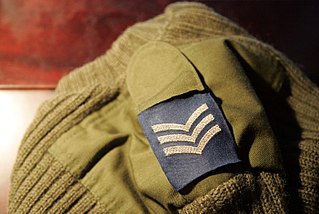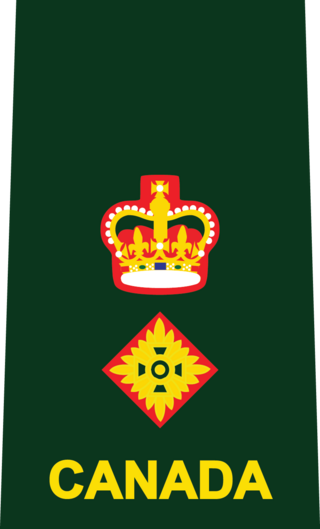A lieutenant is a junior commissioned officer rank in the armed forces of many nations, as well as fire services, emergency medical services, security services and police forces.
Lieutenant Commander is a commissioned officer rank in many navies. The rank is superior to a lieutenant and subordinate to a commander. The corresponding rank in most armies and air forces is major, and in the Royal Air Force and other Commonwealth air forces is squadron leader. It is roughly equivalent to the Corvette Captain rank in central European countries and the Captain 3rd rank rank in eastern European/CIS countries.
Second lieutenant is a junior commissioned officer military rank in many armed forces. The lowest officer rank, it is usually placed below lieutenant or first lieutenant.
Commander is a common naval officer rank as well as a job title in many armies. Commander is also used as a rank or title in other formal organizations, including several police forces. In several countries, this naval rank is termed as a frigate captain.
This is a table of the ranks and insignia of the Canadian Armed Forces. As the Canadian Armed Forces is officially bilingual, the French language ranks are presented following the English.
Officer cadet is a rank held by military cadets during their training to become commissioned officers. In the United Kingdom, the rank is also used by members of University Royal Naval Units, University Officer Training Corps and University Air Squadron; however, these are not trainee officers with many not choosing a career in the armed forces.
Sub-lieutenant is usually a junior officer rank, used in armies, navies and air forces.
Colonel is a Canadian Forces rank used by commissioned officers who wear the army, air force or special operations uniform. Captain(N) is the equivalent rank for officers who wear the navy uniform. A colonel is senior to the army and air force rank of lieutenant-colonel or the naval rank of commander, and junior to the army and air force rank of brigadier-general or the naval rank of commodore.
The officer ranks of the Royal Air Force, as they are today, were introduced in 1919. Prior to that Army ranks were used.
Before Unification as the Canadian Armed Forces in 1968, the Canadian military had three distinct services: the Royal Canadian Navy, the Royal Canadian Air Force, and the Canadian Army. All three services had a Regular (full-time) component and a reserve (part-time) component. The rank structure for these services were based on the services of the British military, the Royal Navy, the Royal Air Force, and the British Army. The change to a "Canadian" rank structure meant that many of the traditional (British) rank titles and insignia were removed or changed.
Lieutenant-general is a Canadian Forces rank used by commissioned officers of the Canadian Army or Royal Canadian Air Force. Vice-admiral is the equivalent rank in the Royal Canadian Navy.

Major is a rank of the Canadian Armed Forces for officers who wear the army or air force uniform. It is equivalent to the rank of lieutenant-commander for officers who wear the navy uniform, and is the lowest rank of senior officer. A major is senior to a captain and junior to a lieutenant-colonel.

These are the official Royal Navy Officer ranks ordered by rank. These ranks are now part of the NATO/United Kingdom ranks, including modern and past.

A shoulder mark, also called a rank slide or slip-on, is a flat cloth sleeve worn on the shoulder strap of a uniform. It may bear rank or other insignia. A shoulder mark should not be confused with a shoulder board, a shoulder knot, or an epaulette, although these terms are often used interchangeably.

In the Canadian Forces, lieutenant-colonel is a rank for officers who wear army or air force uniform. It is equivalent to commander for officers who wear navy uniform and is the second-highest rank of senior officer. A lieutenant-colonel is senior to a major or lieutenant-commander, and junior to a colonel or naval captain.
In the Royal Canadian Navy, the rank of lieutenant-commander (LCdr) is the naval rank equal to major in the army or air force and is the first rank of senior officer. Lieutenant-commanders are senior to lieutenants (N) and to army and air force captains, and are junior to commanders and lieutenant colonels.
Lieutenant (abbreviated Lt, LT (U.S.), LT(USN), Lieut and LEUT, depending on nation) is a commissioned officer rank in many English-speaking nations' navies and coast guards. It is typically the most senior of junior officer ranks. In most navies, the rank's insignia may consist of two medium gold braid stripes, the uppermost stripe featuring an executive curl in many Commonwealth of Nations; or three stripes of equal or unequal width.
Lieutenant is a junior officer rank in the British Army and Royal Marines. It ranks above second lieutenant and below captain and has a NATO ranking code of OF-1 and it is the senior subaltern rank. Unlike some armed forces which use first lieutenant, the British rank is simply lieutenant, with no ordinal attached. The rank is equivalent to that of a flying officer in the Royal Air Force (RAF). Although formerly considered senior to a Royal Navy (RN) sub-lieutenant, the British Army and Royal Navy ranks of lieutenant and sub-lieutenant are now considered to be of equivalent status. The Army rank of lieutenant has always been junior to the Navy's rank of lieutenant.
In the Royal Canadian Navy, the rank of lieutenant(N) (Lt(N)) (French: Lieutenant de vaisseau) is the naval rank equal to captain in the army or air force. When the naval rank lieutenant is written or typed, it is followed by the letter N to indicate that it is a naval rank to distinguish it from army and air force lieutenants (and therefore, the (N) remains silent as it must not be pronounced or replaced by the word (Navy)). Lieutenants(N) are senior to sub-lieutenants and to army and air force lieutenants, and are junior to lieutenant-commanders and majors.
Lieutenant commander, formerly more commonly lieutenant-commander, is a senior officer rank in the Royal Navy of the United Kingdom. It is immediately junior to commander and immediately senior to the naval rank of lieutenant.











